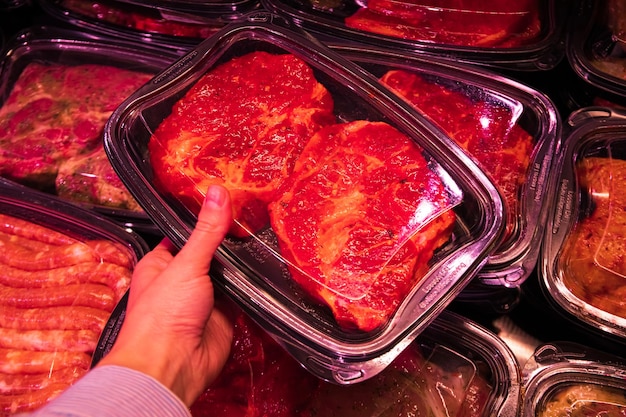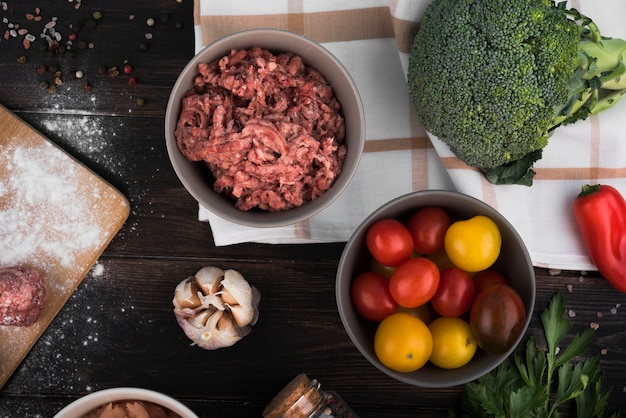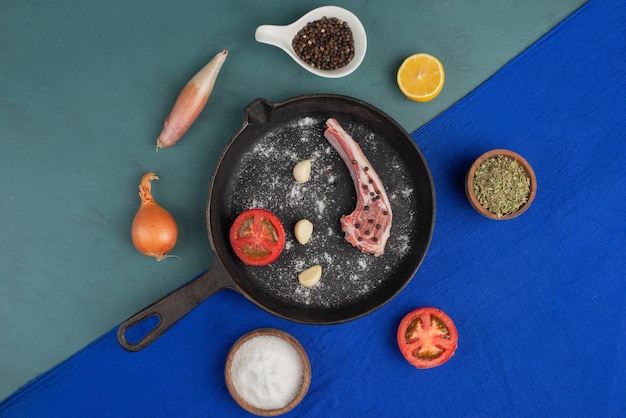I've always been a sucker for a good steak. There's something about that perfectly seared crust, the juicy, tender inside, and the satisfying sizzle as it hits the pan that just gets me going. But let's be honest, getting a steak cooked to perfection isn't always a walk in the park. You can end up with a dry, chewy mess, or worse, a raw centre. I've been there, trust me. Over the years, I've learned a few tricks and techniques, especially when it comes to using cast iron. It's become my secret weapon for achieving steak nirvana. That's why I'm here to share my ultimate cast iron guide to ribeye steak perfection, filled with insider tips and tricks I've picked up along the way.
(Part 1) The Cast Iron Advantage: A Kitchen Hero

Cast iron cookware isn't just a relic from your grandma's kitchen. It's a modern marvel, a true kitchen hero. Its durability and versatility are unmatched, but it's the ability to achieve that beautiful, crispy sear that truly sets it apart. This isn't just about aesthetics; it's about flavour. Cast iron holds heat like a champion, ensuring even cooking and those perfect, caramelized edges that lock in moisture and flavour. Think of it as a little oven on your stovetop, ready to transform your ribeye into a culinary masterpiece.
Why Cast Iron Rules
Let's break down why cast iron is the ultimate choice for steak:
- Unbeatable Heat Distribution: Cast iron distributes heat evenly, ensuring a consistently cooked steak from edge to edge. No more hot spots, uneven cooking, or burnt edges! You'll get a steak that's cooked to your exact liking throughout.
- Superior Heat Retention: Cast iron holds onto heat like a champ. It stays hot for a long time, ensuring your steak cooks through without losing precious heat. This is crucial for achieving that perfect internal temperature and succulent texture.
- The Searing Powerhouse: The surface of cast iron gets incredibly hot, creating that coveted sear that locks in moisture and flavour. It's a beautiful, crispy crust that adds a delightful textural element to your steak.
- Built to Last: Let's be real, these things are practically indestructible. You won't have to replace them anytime soon, making them a sustainable and long-lasting investment in your kitchen.
- Kitchen Workhorse: Cast iron isn't just for steak. You can use it for everything from frying chicken to baking bread. Its versatility is unmatched.
(Part 2) Choosing the perfect ribeye: A Meat Connoisseur's Guide

You've got your trusty cast iron, but you can't just grab any old ribeye and expect it to be perfect. choosing the right ribeye is just as important as the cooking method. Think of it like selecting the perfect ingredients for a winning recipe.
The Ribeye Essentials
Here's what to look for in a top-notch ribeye:
- Marbling: A Sign of Flavour: Marbling, the fat interwoven throughout the muscle, is a key indicator of a juicy, flavorful steak. Look for a ribeye with good marbling; it's a guarantee of succulent flavour and a tender texture.
- Thickness: The Key to Even Cooking: For the best results, go for a steak that's at least 1 inch thick. This allows for even cooking and a beautiful, juicy interior. It's a good rule of thumb to make sure your steak is thick enough to hold its own during cooking.
- Colour: A Fresh and Vibrant Steak: A good ribeye should have a bright, cherry-red colour. Avoid any steaks that look brown or dull, as this could indicate that the meat isn't fresh.
- Texture: Firm and Springy: The meat should feel firm and springy to the touch, not mushy or soft. This is a sign of quality and freshness.
The Butcher's Expertise
If you're feeling unsure, don't hesitate to ask your butcher for advice. They're the experts, after all. They can guide you towards the perfect ribeye for your needs, and even cut it to your desired thickness.
(Part 3) Prepping Your Steak for Cast Iron Glory: A Ritual of Preparation

You've got your cast iron, you've got your ribeye, now it's time to prep your steak for its big moment in the limelight. It's like a chef preparing a masterpiece. Every step counts.
Room Temperature is Key: Letting Your Steak Breathe
Cold meat doesn't cook evenly. Let your ribeye sit at room temperature for about 30 minutes before cooking. This will allow it to cook evenly and reach a delicious internal temperature. Think of it as letting your steak relax and come to a comfortable temperature.
Pat It Dry: The Quest for a Crispy Crust
Wipe those tears of joy from your ribeye, and pat it dry with paper towels. This will help the steak to develop a beautiful, crispy crust. Excess moisture will steam the steak, preventing a good sear.
Salt and Pepper: The Essential Duo
Salt and pepper are the best friends of a ribeye. Season liberally about 30 minutes before cooking. This allows the salt to penetrate the meat and draw out moisture, enhancing the flavour. It's basically giving your steak a spa day, prepping it for its star turn.
Oil Up Your Cast Iron: A Coating of Protection
Heat a thin layer of oil in your cast iron skillet over medium-high heat. The oil helps to prevent sticking and creates a crispy, flavorful crust. Don't skimp on the oil; a generous coating is crucial for a successful sear.
(Part 4) Searing to Perfection: A Masterclass in Heat
The time has come to unleash your inner grill master. You're about to sear that ribeye like a pro. This is where your cast iron really shines.
The Sear: The First Step to Deliciousness
Place the ribeye in the hot cast iron skillet and let it cook undisturbed for about 3-4 minutes per side. Resist the urge to move the steak around; this will disrupt the sear and prevent a crispy crust. Let the heat do its magic.
Flip It Like It's Hot: A Dance with Heat
Flip the steak over and cook for another 3-4 minutes per side. You'll know it's done when the internal temperature reaches your desired level. Use a meat thermometer to check the temperature accurately.
Resting is Key: Letting the Juices Settle In
Once the steak is cooked to your liking, remove it from the pan and let it rest for at least 5 minutes before slicing. This allows the juices to redistribute throughout the meat, resulting in a more tender and juicy steak. It's like giving your steak a moment to breathe and relax after its intense workout in the pan.
(Part 5) Cooking Temps for Steak Perfection: Mastering the Art of Doneness
Now, let's talk about how to cook your steak to the perfect doneness. It's not about following strict rules, but understanding the different levels of doneness and how they translate to taste and texture.
steak doneness Guide: A Journey Through Taste
This chart will guide you to steak perfection:
| Doneness | Internal Temperature (°F) | Internal Temperature (°C) | Description |
|---|---|---|---|
| Rare | 125-130 | 52-54 | Cool red center, warm edges. This is for those who like their steak with a pronounced raw center, offering a cool, juicy texture. |
| Medium Rare | 130-135 | 54-57 | Pink center, warm edges. A popular choice for a tender steak with a hint of pink in the center. It provides a balance of flavor and tenderness. |
| Medium | 140-145 | 60-63 | Pink center, slightly warm edges. A classic choice for a well-cooked steak, with a hint of pink in the center and a warm, juicy texture. |
| Medium Well | 150-155 | 65-68 | Slight pink center, mostly brown. A steak with a slightly pink center, but primarily cooked through, offering a more substantial texture. |
| Well Done | 160 | 71 | All brown, no pink. For those who prefer their steak fully cooked, with a brown center and a firm texture. |
(Part 6) The cast iron care Guide: A Love Affair With Your Cookware
Now that you've conquered the art of cast iron steak, it's time to talk about taking care of your trusty cast iron. You'll want this beauty to be your kitchen companion for years to come.
Washing Up Like a Pro: Gentle Cleaning for a Durable Finish
Cast iron is a bit of a diva. It doesn't like dishwashers or harsh detergents. Just scrub it with warm water and a scrub brush. A gentle approach will keep your cast iron in pristine condition.
The Drying Ritual: Keeping Rust at Bay
After washing, dry your cast iron immediately and thoroughly. Moisture can cause rust, so a quick drying ritual is crucial to maintaining its longevity.
Seasoning Your Cast Iron: A Protective Shield
Regularly seasoning your cast iron is key to keeping it in tip-top shape. It creates a protective layer that prevents rust and ensures even cooking. Think of it as a little shield for your cast iron, guarding it from the elements.
The Seasoning Process: A Step-by-Step Guide
- Heat the Cast Iron: Heat your cast iron over medium heat.
- Apply Oil: Rub a thin layer of oil, like flaxseed or grapeseed oil, all over the surface of the cast iron.
- Let it Bake: Place the cast iron in a preheated oven at 350°F (175°C) for 30 minutes. This will allow the oil to bake onto the surface, creating a smooth, nonstick finish.
- Cool and Repeat: Let the cast iron cool completely before wiping off any excess oil. You can repeat this process several times for a better seasoned finish.
(Part 7) Cast Iron steak sides: A Symphony of Flavours
You've got the perfect steak, but what about the sides? Here's a selection of classic and exciting sides that pair beautifully with your ribeye, creating a harmonious culinary experience.
Classic Sides: A Timeless Pairing
- Roasted Vegetables: Roast some potatoes, asparagus, or Brussels sprouts for a hearty and flavorful side that complements the richness of the steak. The roasting process brings out the natural sweetness of the vegetables.
- mashed potatoes: A classic comfort food that complements the richness of a ribeye. Creamy and comforting, mashed potatoes add a touch of elegance to your steak dinner.
- Creamed Spinach: A simple but elegant side dish that adds a touch of green to the plate. Its creamy texture and earthy flavour provide a delightful contrast to the steak.
Something Different: Exploring New Flavour Combinations
- grilled corn on the Cob: A summery and delicious side that perfectly complements the char of the steak. The smoky flavour of the corn adds another dimension to your meal.
- sweet potato Fries: A crispy and satisfying alternative to traditional fries. The sweetness of the sweet potatoes adds a delightful contrast to the savoury steak.
- Mushroom Risotto: A creamy and flavorful risotto with a touch of earthy mushroom goodness. The richness of the risotto balances the hearty flavour of the steak.
(Part 8) The Cast Iron Steak Experience: More Than Just a Meal
Here's the thing: cooking a steak on cast iron isn't just about the process, it's about the experience. It's about the sizzle, the aroma, the anticipation. It's about gathering around the table with friends and family, sharing a meal and creating memories.
The Perfect Setting: Creating a Culinary Oasis
For a truly unforgettable steak experience, set the scene. Dim the lights, light a few candles, and play some soothing music. It's about creating a relaxed and enjoyable atmosphere that elevates the dining experience.
The Final Touches: Adding a Splash of Creativity
Add a splash of creativity. Serve your steak with a drizzle of olive oil, a sprig of rosemary, or a few flakes of sea salt. It's the little details that make all the difference, turning a simple steak dinner into a culinary masterpiece.
FAQs: Demystifying Cast Iron steak cooking
1. What if my cast iron isn't seasoned?
Don't worry, you can always season it! Follow the seasoning steps above, and you'll have a beautiful, nonstick finish in no time. It's a simple process that will transform your cast iron into a seasoned pro.
2. Can I use cast iron on an induction cooktop?
Cast iron can be used on an induction cooktop, but you might need a cast iron adapter. These adapters create a magnetic field that allows the cast iron to interact with the induction cooktop.
3. How do I clean up a rusty cast iron skillet?
If your cast iron develops rust, you can remove it with a scouring pad and a little bit of water and dish soap. Once you've removed the rust, re-season the cast iron. It's a simple fix that will restore your cast iron to its former glory.
4. What are the best oils for seasoning cast iron?
Flaxseed oil, grapeseed oil, and canola oil are all excellent choices for seasoning cast iron. These oils have a high smoke point, which means they can withstand high heat without burning.
5. What temperature should I cook a ribeye to?
The temperature you cook your ribeye to depends on your personal preference. Check out the doneness chart above for guidance. Remember, a good internal temperature is crucial for a juicy and tender steak.
So, there you have it. My ultimate cast iron guide to ribeye steak perfection. It's about the journey, the process, and the shared experience. So, grab your cast iron, choose a beautiful ribeye, and get ready to cook up some culinary magic. Enjoy!
Everyone is watching

Corn on the Cob: The Ultimate Guide to Perfectly Cooked Ears
Healthy MealsAh, corn on the cob. Just the name evokes images of sunny days, barbecues, and that sweet, juicy flavour that ...

Perfect Pork Roast Oven Cooking Time: A Guide to Delicious Results
Healthy MealsThere's something truly satisfying about a perfectly roasted pork. The aroma alone is enough to make your mout...

Ham Cooking Time: How Long to Bake, Smoke, or Boil a Delicious Ham
Healthy MealsAh, ham. It's a classic, isn't it? A real crowd-pleaser, especially around holidays. And when done right, it'...

Scallops: The Ultimate Guide to Perfect Cooking
Healthy MealsAh, scallops. Those delicate, sweet, and utterly delicious morsels of the sea. They hold a special place in my...

Spaghetti Squash: The Ultimate Guide to Cooking and Serving
Healthy MealsRemember that time you saw spaghetti squash at the supermarket, looking all bumpy and strange, and thought, "W...
